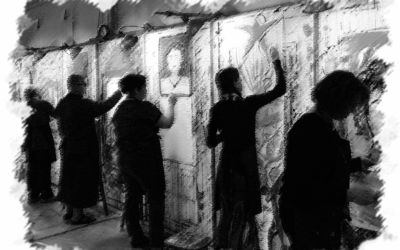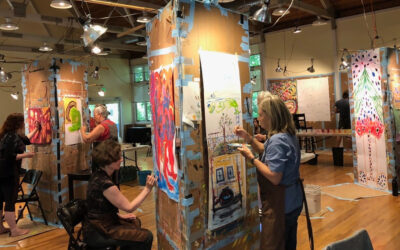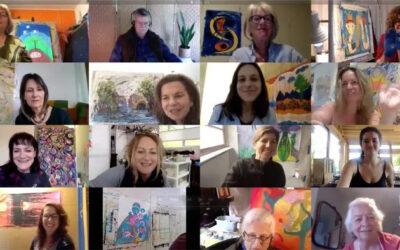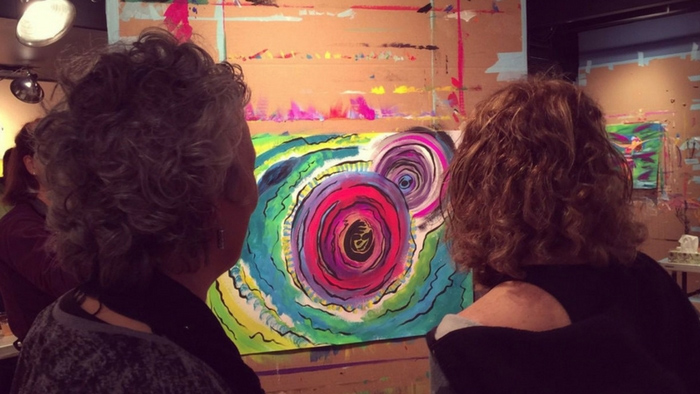
One of the ways our facilitators support painters at The Painting Experience is to direct them toward what they are feeling, or sensing, to access the body’s intelligence and to help bypass the thinking mind. We will ask questions that help you notice what you are feeling while you are painting — and the body is where feelings live.
It is not uncommon for us in this culture to have a limited feeling vocabulary. We often lack the ability to know what we feel and, frequently, we confuse feelings with emotions. But feelings are different. We always have sensations — for example, hot, cold, tender, sharp, prickly, smooth, pain, thirst, or hunger. These are feelings picked up by one of the five senses. On the other hand, emotions happen when the mind makes a connection to our sensations and feelings and identifies them as anger, sadness, fear, joy, and so on, usually based on past experience or because of their intensity. (If you’re interested in learning more about the subtleties of this topic, see the links at the bottom of this article.)
We often use the word “sense” to guide you toward what you are feeling. We may ask, “What are you sensing?” to help you listen inward to what might want to arise. We also use the word “energy” because it helps us listen to the subtle feelings in our body without defining them as emotion: Where is the energy? Is there energy in that image or color or gesture for you? These questions get at the felt sense of what is available in the body’s intelligence.
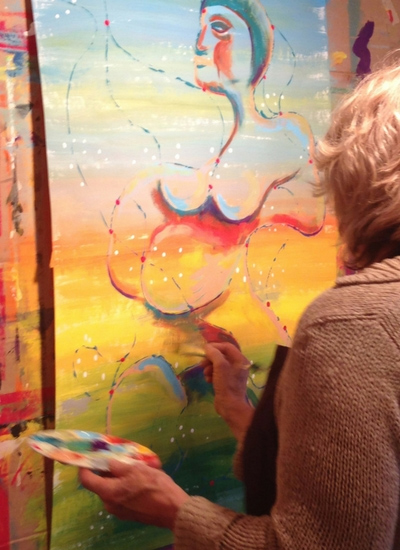
Painting Brings Us Back to Body Intelligence
Listening to what our bodies want to do is a new way for most of us to pay attention but, when we are able to do it, we realize the information is often readily available and easy to read. Working this way can help us become clear about situations in our lives where our body is telling us that we don’t want to do something that our mind has been trying to convince us to do. We may start to realize that our body is saying something different from our mind — perhaps that’s why we have a stomachache or a headache. The Painting Experience is a way to get back to body intelligence. It helps us listen to the body’s true messages, unbiased by beliefs, past experiences and outward influences.
Sometimes we don’t want to listen to our bodies because they are in physical or emotional pain. Who wants to go there!? But surprisingly, going toward the pain can be a helpful release if we can learn how to work with it attentively.
Let’s say you have a nagging pain in your shoulder. Can you feel into the pain for a moment to find out about it? Is it sharp, is it a dull ache, does it feel like a knot, or is it a searing pain? What color comes to mind? What shape? Can you listen to that pain and let it express itself onto the paper? Is there a pile of dark, knotty rope that wants to be wound up on your paper — or is there a gray, steel knife stabbing something and bleeding? These images can give relief to some kinds of pain. They come from your imagination, from the same realm as dreams, and they create a symbolic connection to something in you that can be released through expression.
Or let’s say you have some emotional pain: fear, sadness, anger, or the like. First of all, notice whether you can find a connection to the emotion somewhere in your body: a tight throat, chest or stomach? Maybe it’s just a feeling of butterflies or a palpable sensation that moves around. Work with whatever you can find. Go into your experience and find out what color, what shape, what texture it wants to express. Find out what it needs. You are here to listen, to give your feelings a voice. When you find the right expression, you will know because the difficult emotion or tension will release. You will probably also feel lighter and easier once you have found an authentic way to express what has been trapped.
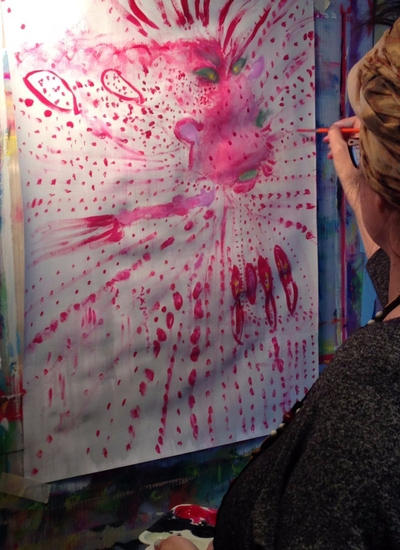
You may be afraid that moving toward pain will increase it, especially emotional pain. This is a natural reaction. But your fear is likely to create more discomfort than moving toward the pain with curiosity. Keep in mind that by moving toward something dark or painful, we are not making it manifest in our lives. We are simply expressing something that is already there. Keeping it locked into our bodies is far more harmful than letting it out and expressing it through image and color and gesture.
Even if you are unable to completely work through a body pain, it will likely take a back seat while you are painting. Focusing on the creative process often reduces suffering. Holding an open curious mind is always beneficial because it prevents additional anxiety and tension from accumulating in the body.
Allow yourself to be guided by the body’s own remarkable intelligence and be prepared to be surprised and delighted at the deep connection that it brings you in your creative process.
More Information
Larisa Noonan offers a great list of sensations to help you expand your vocabulary of feelings, from trembly to buzzy to hollow or flowing. She also offers guidance on how to learn from and work with sensations.
Just Conflict offers an in-depth article exploring the differences between sensations, emotions, thoughts and wishes.
Annie Rousseau is a Senior Facilitator of The Painting Experience. You can paint with her next at Ocean Resort on Vancouver Island from August 25-30 or at Whistler/Pemberton from September 22-24.

